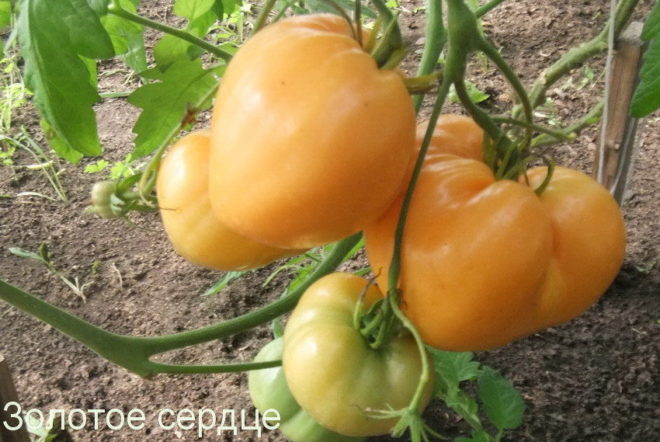 The tomato with the characteristic name "Golden Heart" was bred by domestic breeders for a long time - back in 2001, and since then it has been very popular among gardeners.
The tomato with the characteristic name "Golden Heart" was bred by domestic breeders for a long time - back in 2001, and since then it has been very popular among gardeners.
Such fame is quite cold - the variety showed its best side, and, in addition to the wonderful taste, tomatoes contain a lot of carotene, do not cause allergies, are ideal for diet and even baby food.
Content
Golden Heart variety characteristics and description
The bush variety is determinant, i.e. even in a greenhouse no more than 120 cm tall, in the open air - 50-80 cm. Fruits are tied with brushes of 3-7 pieces. When growing even on the street, the yield from the bush is 2.5 kg, in the greenhouse by the middle of summer it is up to 7 kg per square meter, and subject to the rules of agricultural technology - even more.
As for the appearance of the fruit, the name speaks for itself - the color is yellow-orange and bright, and the characteristic, slightly oblong shape with a pointed tip resembles a heart. You can see them in the photographs.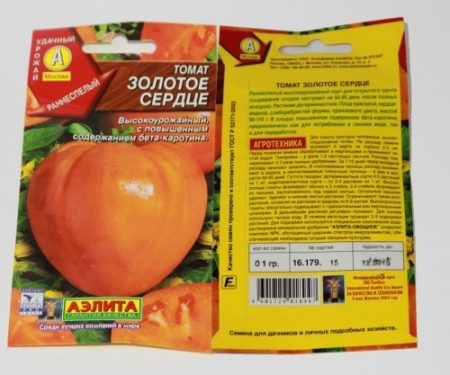
Tomatoes grow on average 100-250 grams, taste sweet, delicious, fleshy, with small chambers for seeds. The peel is dense, which is also valuable - the fruits are not prone to cracking and are quite flat. Slightly ribbed at the stalk.
The purpose of the variety is fresh consumption, since tomatoes are very tasty, small fruits are suitable for whole preservation, large fruits for processing for winter harvesting, juices, tomato paste.
The variety is ripe, in 85-90 days from seedlings the first fruits begin to ripen.
Features of the variety, its disadvantages and advantages
Distinctive features of the variety are:
- ultra-precocity, relative cold resistance and yield at the same time;
- resistance to drought;
- delicious taste, high carotene content (up to 3.75 mg);
- fruits are not watery, sweet, acid free;
- decorative look;
- resistance to underlying diseases.
There are some minor flaws:
- at high humidity prone to late blight, although less than most yellow varieties;
- in a greenhouse, under too hot and humid conditions, the bush can stretch up to 2 meters, so in a hot climate it is better to grow on the street.
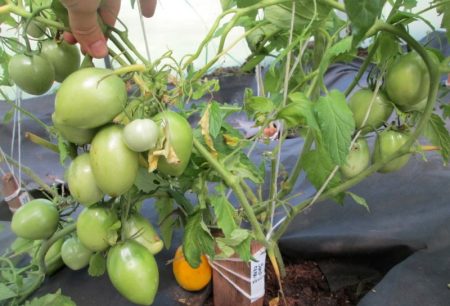
Growing and caring for the Golden Heart tomato
The variety is quite unpretentious, but to increase productivity, you should still study the rules of agricultural technology.
Sowing and seedling care
Sowing begins in March, according to the lunar calendar. The variety is very early, so we count 50-60 days before planting in a greenhouse or open ground, otherwise the seedlings will stretch and outgrow, and this will delay the harvest. Thus, the southern regions begin sowing in early March, the more northern - at the end, or even at the beginning of April.
Land can be purchased, or garden, mixed with peat, sand and humus for friability and fertility (it is important to decontaminate in the oven or pour boiling water or potassium permanganate).
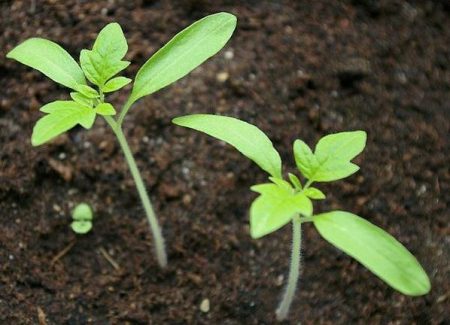 Soak the seeds for several minutes in potassium permanganate, then treat with a growth stimulator.
Soak the seeds for several minutes in potassium permanganate, then treat with a growth stimulator.
Seeding depth - 1-2 cm.Before the first shoot, you can cover with a film so that the earth does not dry out. It is better to sow in a box, so that in the phase of 2 leaves to pick, (tomatoes well tolerate this procedure, it is even useful to them).
Seedlings need bright light and long daylight hours. The temperature is 20-23 degrees. In cloudy weather, the additional use of backlighting with lamps or reflective screens will help seedlings not to stretch out.
Growing in a greenhouse and open field
Tomatoes are planted in a permanent place after the threat of frost passes, up to 4 pieces per 1 sq. Km. meter, the bush is quite compact, you can save space.
Like all tomatoes, Golden Heart does not tolerate frosts, but it experiences persistently lowering temperatures. Therefore, it is recommended for cultivation, both in warm and temperate, cool climates.
Periodically, you need to loosen the ground between the bushes and weed out in time. In hot climates (or just in hot weather), mulching the soil is very effective.
Watering
Regular watering is needed so that the soil does not dry out deeply, but does not sour. Before abundant fruiting, no more than 2 times a week, then less often. Excess moisture leads to cracking and watery fruit.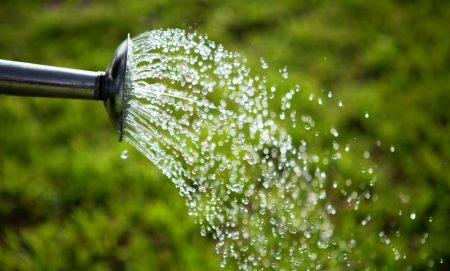
The water should not be cold and settled, otherwise the plant may lose flowers from shock.
Fertilizer
The first fertilizing with nitrogen-containing fertilizers can be done shortly after the pick.
During planting in a permanent place, humus, ash, and a little superphosphate are added to each well.
Since the beginning of the tying of the first fruits, and for the entire season, 3-4 fertilizing with mineral fertilizers is carried out, this will prolong fruiting.
Stepson and garter
The bush must initially be formed in 1-2 stems, the remaining shoots should be removed. Garter is needed, especially since the time of fruiting, so that the plant does not fall or break under the weight of the fruit.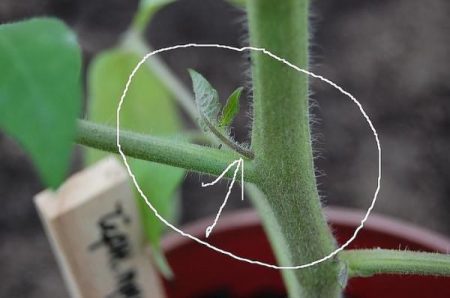
Diseases and Pests
The variety is very resistant to disease, but the basic rules must be observed:
- disinfect the ground, especially in a greenhouse (it is advisable to change it periodically in it);
- Do not plant seedlings in the beds where tomatoes, eggplant, peppers or potatoes grew last season;
- prevent diseases by periodically spraying bushes with a solution of potassium permanganate and copper-containing preparations.
Pests also start from non-compliance with temperature and humidity conditions. This is a spider mite, whitefly, common aphid and thrips. You can fight parasites with safe, folk remedies (onion infusion or celandine broth, ammonia solution, soapy water, etc.). If there are many pests, but simple remedies did not help, then insecticides will help.
Harvesting and storage
Harvesting during the summer is carried out as the fruits ripen, they begin to sing quickly in the garden. By autumn, green tomatoes can be cut off and stored in boxes - they ripen perfectly. Even matured under such conditions and during long-term storage, they do not lose their taste too much.
Tomato "Golden Heart" will be able to grow even novice gardeners, while receiving a good harvest.
Reviews about the tomato "Golden Heart"
Most gardeners who have tried to grow Golden Heart tomato, recommend a variety, respond well.
“Last season, I first tried to grow a Golden Heart. I was satisfied - fruiting along with my favorite varieties, the fruits quickly turned yellow right in the greenhouse. Usually, yellow varieties have a too thin skin and are prone to cracking, but I did not observe this at Golden Heart. I will plant more. ”
“For several years, I have been planting a Golden Heart periodically.I like that the bush is quite compact, the fruits begin to be tied and ripen together. The taste seemed to me not very saturated tomato, but tender, sweet, not watery. In my opinion, this is one of the best varieties for fans of the taste of yellow or orange tomatoes. "




 Low-growing tomatoes, without pinching: 5 of the most delicious varieties
Low-growing tomatoes, without pinching: 5 of the most delicious varieties Why tomato seedlings grow poorly
Why tomato seedlings grow poorly We grow a tomato in a shell
We grow a tomato in a shell Growing tomatoes without watering according to the method of Kazarin
Growing tomatoes without watering according to the method of Kazarin